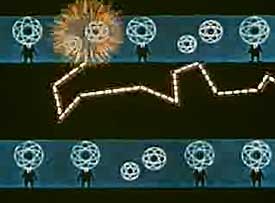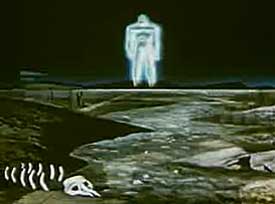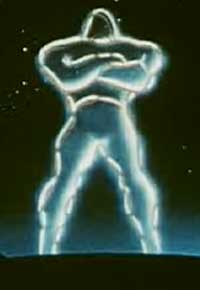Radiation Safety in Nuclear Energy Explorations (c.1953) is a propaganda film for children, with some animation, produced by the Department of Health, Education, & Welfare, Public Health Service Division of Radiological Health, & the U.S. Atomic Energy Commission. It begins with an establishing shot depicting children playing with toy rockets.
 The narrator admits that atomic energy presents some risk of all of these kids getting killed. But of course the risk is very small & probably nothing to fret about. Even so, it's the government's responsibility to get the kids paranoid about it, just on the off-chance of encroaching doom "while the advantages of nuclear energy are being developed." The narrator admits that atomic energy presents some risk of all of these kids getting killed. But of course the risk is very small & probably nothing to fret about. Even so, it's the government's responsibility to get the kids paranoid about it, just on the off-chance of encroaching doom "while the advantages of nuclear energy are being developed."
There follows some claims that nuclear energy is being used to propel ships at sea & light up cities, to feed the masses with advances in agriculture, treatment of thyroid disease, & so on.
It procedes to claim that the Atomic Energy Commission exists to extend these practical peace-time values, including in outer space (in reality the "civilian" space program was strictly to scare the bejabbers out of the Russians, so they'd know we could deliver nuclear weapons to their cities from space).
We're told there are even "peaceful uses of nuclear explosions" which is alleged to benefit agriculture by some unspecified means. Nuclear bombs are alleged to be practical for creating new harbors, canals, & for mining for minerals. It's impossible to believe the government ever really thought such uses were plausible.
When I was a wee sprite, I recall the claim that nuclear bombs could be used to carve out new deep-water ports beside cities. Of course that would fry the nearby city & scatter enough fallout to make a good part of the world uninhabitable thereafter, & the government's testing that in the Bikini Atoll had already made this perfectly clear. But hey, deepwater seaport!
Surprisingly dull, not as accidently terrifying as some of these films, blandly reassuring that if we keep making lots & lots of bombs this will help medical science & mining & sea exploration. So what time is it kids? Time to make more bombs!
A is for Atom (1953) is a quarter-hour animated film that begins with the usual "atomic fear" information about "the giant of limitless power" depicted as a mushroom cloud turning into a radioactive colossus with arms folded over his beefy chest.
 Produced by John Sutherland with funding from one of the key manufacturers of nuclear bomb components, General Electric, we're about to be treated to the Eisenhower variety of calculated Cold War propaganda aimed at children. Produced by John Sutherland with funding from one of the key manufacturers of nuclear bomb components, General Electric, we're about to be treated to the Eisenhower variety of calculated Cold War propaganda aimed at children.
Dr. Atom is introduced, a professor with an atom for a head. If the colossus seen at the beginning can be likened the personification of what Oppenheimer called the "destroyer of worlds," then Professor Atom by contrast is our friendly buddy.
He steps out from behind his desk while the narrator explains how his head, the giant atom, works. The elementary instructional on the nature of atoms & isotopes is one of the better lectures found in any such film.
The discovery of fusion & the initial & foremost use of this new technology to build bombs is outlined. Two-thirds of the way through the film, we still haven't been given even one peacetime use.
It's a bit odd they don't outline upfront the medical uses of radiology or fusion as a source of energy for household appliances which would've been typical reassurances of the era. For the bulk it comes off as a useful teaching film about the actual science.
Synoptic by necessity, at least one omission seems inadvertently sexist. When A is for Atom speaks of "Men of Science" & the discovery of radioactivity in radium, it's too bad they don't mention the chief "Man" was Madame Curie, or that she died from radiation sickness pursuing this knowledge.
At first glance A is for Atom appears to be the most educative & least propagandistic film about nuclear energy produced in the late 1940s through the 1960s, as the usual misleading touchstones are lacking in favor of an animated overview of the science. We're not told we'll survive nuclear holocaust if we "duck & cover" when we see the bombs flashing in the sky, as this one's just not Civil Defense rhetoric.
But A is for Atom was in the vanguard of corporate America promoting nuclear power under the banner of "peace." It's what Kenneth Osgood in Total Cold War: Eisenhower's Secret Propaganda Battle at Home and Abroad (University Press of Kansas, 2006) called "quite possibly the largest single propaganda campaign ever conducted by the American government," i.e., the Atoms For Peace campaign.
Dwight Eisenhower delivered his key "Atoms for Peace" speech at the United Nations. Throughout his presidency he would promote the "peaceful" uses of atomic fussion in typical "new-speak" that translated "peace" as "military build-up." The campaign's actual intent was to eliminate all restraints on America testing & stockpiling nuclear weapons.
 A big example of how it worked was the promotion of the Hanford Nuclear Plant as primarily to provide electrical power to light our homes & operate our kitchen appliances & keep us warm. A big example of how it worked was the promotion of the Hanford Nuclear Plant as primarily to provide electrical power to light our homes & operate our kitchen appliances & keep us warm.
The real purpose of Hanford was from the start the purification of plutonium that served no other purpose than for nuclear war, which is why to this day the American government never believes any other country's nuclear plants are really for domestic energy purposes, the US having been the inventors of this lie.
Numerous propaganda films would be produced through a variety of "independent" film studios to give the impression of grass roots support, & articles "planted" in non-government magazines (most notorious is the propaganda essay "Man's New Servant: The Friendly Atom" in a 1954 issue of The National Geographic), together with material generated by major universities (with military grants) to give it all an academic veneer.
It takes nearly the entire length of the film to finally get round to what radio isotopes are good for besides war, but finally we learn they're used in making aluminim foil really thin, for medical research, & other stuff totally unrelated to fussion or the vaunted Hanford facility championed by this film.
It closes with terrifying imagery of our personified atomic energy sources. Number one is "the warrior, the destroyer" shown as the same radioactive colossus seen at the start of the film. "Another is the engineer" shown to be a radioactive colossus of the energy grid lighting up cities & machinery.
"Another is the farmer" is shown to be a radioactive colossus standing over a polluted bone-strewn riverbed, I kid you not, how'd they get that bit of truth in there??? Fourth is "the healer" the scariest colossus of all with his blank radioactive visage & his war-shield with a caduceus on it. These four cosmic giants stand over us watching us like Big Brother ready to help us or exterminate us as we individually deserve.
"And the last is the research worker" who is also radioactive. These are shown melding into a single cosmic giant standing on the globe of the earth with arms crossed. The narrator says: "On man's wisdom the use of that power depends." Which to many didn't sound hopeful at all.
copyright © by Paghat the Ratgirl
|

 The narrator admits that atomic energy presents some risk of all of these kids getting killed. But of course the risk is very small & probably nothing to fret about. Even so, it's the government's responsibility to get the kids paranoid about it, just on the off-chance of encroaching doom "while the advantages of nuclear energy are being developed."
The narrator admits that atomic energy presents some risk of all of these kids getting killed. But of course the risk is very small & probably nothing to fret about. Even so, it's the government's responsibility to get the kids paranoid about it, just on the off-chance of encroaching doom "while the advantages of nuclear energy are being developed." Produced by John Sutherland with funding from one of the key manufacturers of nuclear bomb components, General Electric, we're about to be treated to the Eisenhower variety of calculated Cold War propaganda aimed at children.
Produced by John Sutherland with funding from one of the key manufacturers of nuclear bomb components, General Electric, we're about to be treated to the Eisenhower variety of calculated Cold War propaganda aimed at children. A big example of how it worked was the promotion of the Hanford Nuclear Plant as primarily to provide electrical power to light our homes & operate our kitchen appliances & keep us warm.
A big example of how it worked was the promotion of the Hanford Nuclear Plant as primarily to provide electrical power to light our homes & operate our kitchen appliances & keep us warm.